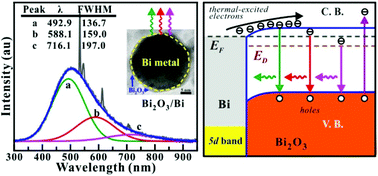Size-controllable synthesis of Bi/Bi2O3 heterojunction nanoparticles using pulsed Nd:YAG laser deposition and metal–semiconductor-heterojunction-assisted photoluminescence†
Abstract
We synthesized Bi/Bi2O3 heterojunction nanoparticles at various substrate temperatures using the pulsed laser deposition (PLD) technique with a pulsed Nd:YAG laser. The Bi/Bi2O3 heterojunction nanoparticles consisted of Bi nanoparticles and Bi2O3 surface layers. The average diameter of the Bi nanoparticles and the thickness of the Bi2O3 surface layer are linearly proportional to the substrate temperature. The heterojunctions between the Bi nanoparticles and Bi2O3 surface layers, which are the metal–semiconductor heterojunctions, can strongly enhance the photoluminescence (PL) of the Bi/Bi2O3 nanoparticles, because the metallic Bi nanoparticles can provide massive free Fermi-level electrons for the electron transitions in the Bi2O3 surface layers. The enhancement of PL emission at room temperature by metal–semiconductor-heterojunctions make the Bi/Bi2O3 heterojunction nanoparticles potential candidates for use in optoelectronic nanodevices, such as light-emitting diodes (LEDs) and laser diodes (LDs).


 Please wait while we load your content...
Please wait while we load your content...